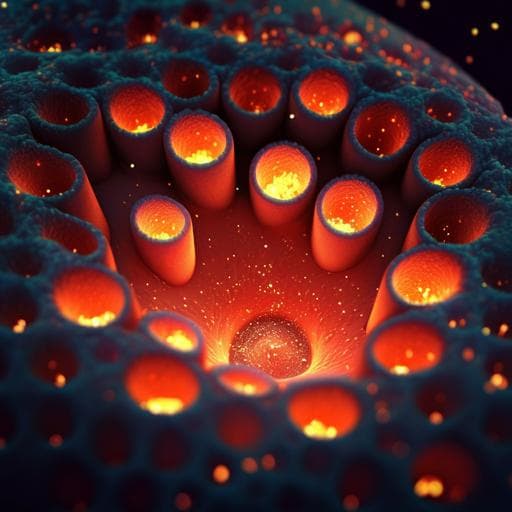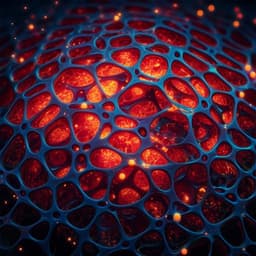
Engineering and Technology
Quaternary functionalized mesoporous adsorbents for ultra-high kinetics of CO₂ capture from air
T. Wang, X. Wang, et al.
Discover a groundbreaking direct air capture (DAC) adsorbent with unprecedented CO₂ capture kinetics, developed by researchers Tao Wang, Xinru Wang, Chenglong Hou, and Jun Liu. This innovative material showcases superior moisture swing adsorption capabilities with an impressive half-time of just 2.9 minutes, making it a game-changer in carbon capture technology.
~3 min • Beginner • English
Introduction
The need to limit global warming to below 1.5 °C has driven interest in Negative Emission Technologies capable of removing ~100 Gt CO₂ by mid-century. Direct air capture (DAC) using chemical sorbents offers low environmental risk, compatibility with CO₂ utilization, and effectively unlimited capacity, but faces severe kinetic limitations at the very low CO₂ partial pressure of ambient air (~40 Pa). While artificial sorbents can outperform natural sinks by orders of magnitude, translating flue-gas capture technologies (e.g., alkali hydroxides, solid amines) to DAC requires careful pore and functionality design to enable both functionalization and CO₂ diffusion. Conventional impregnation methods often fill small pores (<10 nm), impeding diffusion post-functionalization, thus low amine loading or in situ polymerization strategies are used to retain mesoporosity. This work targets chemically grafted quaternary ammonium (QA) groups onto mesoporous polymers to create DAC adsorbents that operate via moisture swing adsorption (MSA), where water triggers desorption rather than heat or electricity, potentially lowering energy use. Mesoporous supports are introduced to enhance molecular diffusivity and to avoid functional group overlap, providing high surface area for grafting and sufficient CO₂ transport channels. Given that water modulates QA–CO₂ binding via Brønsted base mechanisms, mesopore water behavior (diffusion, capillary condensation) is expected to strongly affect MSA performance. The study investigates how mesopore architecture and functionalization strategy govern capacity, efficiency, and kinetics for DAC.
Literature Review
The paper situates DAC within the broader NETs portfolio and highlights kinetic constraints at ambient CO₂ levels. Prior sorbent developments include alkali hydroxides and solid amines, with recognition that impregnation often preferentially occupies small pores, hindering diffusion; retaining mesoporosity requires limiting loading or employing in situ/hyperbranched polymerization. Moisture-swing adsorbents based on quaternary ammonium chemistry have been reported to offer lower energy regeneration compared to temperature swing, with performance sensitive to anion selection and material hydrophilicity. Gel-type ion exchange resins typically exhibit high ion-exchange efficiency (>98%) due to uniform cation spacing in crosslinked networks. Previous MSA materials on macroporous supports or cellulose showed limited pore architecture for diffusivity enhancement. Literature also establishes that water content around QA sites and capillary condensation in mesopores (Kelvin equation) can elevate local humidity, thereby altering QA–CO₂ binding thermodynamics and MSA behavior. This work builds on these insights by grafting QA groups into mesoporous polystyrene-divinylbenzene resins to balance high diffusivity, functional group accessibility, and moisture-regulated binding.
Methodology
Sorbent synthesis (QMPRs): A three-step route was used starting from commercial nonpolar mesoporous polystyrene-divinylbenzene resins (XAD-4, XAD-16, XAD-1180N). 1) Friedel–Crafts acylation: 4.00 g dried resin was swollen in dichloromethane (20 mL, 12 h), then reacted with chloroacetyl chloride and anhydrous AlCl₃ (molar ratio resin:reagent:catalyst = 1:1:1) at 25 °C for 4.5 h under N₂, followed by washing (THF, 0.1 M HCl, DI water) to obtain MPR-CA intermediates. 2) Trimethylaminization: MPR-CA was swollen in MeOH (20 mL, 6 h), then reacted with 60 wt.% trimethylamine (3.0 eq based on chloroacetyl chloride) at 70 °C for 4 h (reflux). The product (MPR-CI) was column-washed with MeOH and DI water and dried (60 °C, vacuum, 12 h). 3) Ion exchange: MPR-CI was exchanged with 1 M Na₂CO₃ solution to yield QA-functionalized mesoporous anion exchange resins (QMPRs) bearing carbonate counter-ions. Swelling agents (CH₂Cl₂, MeOH) were chosen to overcome steric hindrance and deliver reagents into substitution sites. Carbonate counter-anion was selected for strong interaction with CO₂ under ambient conditions. Three pore-structured variants (QMPR-1, -2, -3) were prepared from different starting resins.
Characterization: N₂ adsorption–desorption (ASAP2020) provided BET surface area (0.01<P/P₀<0.1), total pore volume at P/P₀ = 0.99, and DFT pore size distributions. FTIR (ATR) confirmed chemical structures. Elemental analysis (C, H, N) quantified nitrogen loading; Mohr titration quantified residual chloride to derive ion charge density (ρi) and estimate ideal CO₂ capacity. SEM (Hitachi SU-8010) imaged particle and internal pore morphology.
CO₂ adsorption measurements: A custom 8 L system was used; leakage verified negligible (1.4×10⁻⁴ ppm s⁻¹ at ΔCO₂ = 500 ppm). For isotherms, 4.00 g QMPR was pre-dried under UHP N₂; RH controlled at 21% and T = 20 °C. Stepwise CO₂ injections were made to equilibrium, and adsorbed amount computed by mass balance. Isotherm models (Langmuir, Freundlich, Temkin) were fitted in linearized forms to equilibrium data. Kinetics were evaluated by monitoring CO₂ concentration vs time to calculate sorbent saturation θ(t). PFO, PSO, and mixed 1,2-order (MOE) models were fitted; adsorption half-time (t₁/₂) was derived from MOE fits.
H₂O adsorption: Gravimetric sorption at set RH was measured: samples were dried (mass ma), then exposed to humid N₂ until stable mass mw; water uptake Qw = 1000(mw − ma)/(18ma).
Key Findings
- Successful QA grafting on mesoporous polystyrene resins produced MSA-capable DAC adsorbents (QMPR-1, -2, -3) with similar particle sizes (~500–600 µm) and distinct mesopore architectures.
- Pore structure: All MPRs showed type IV isotherms; MPR-1 exhibited H2 hysteresis (ink-bottle mesopores), MPR-2 H1 hysteresis (uniform cylindrical mesopores), MPR-3 mesopores with macropore contribution (>50 nm). Quaternization preserved pore types but reduced pore volume (notably 30–50 nm range) due to swelling; surface areas generally increased except QMPR-3 where combined swelling/amination decreased area.
- Textural properties (selected, from Table 1): For QMPR-2 vs MPR-2, BET surface area increased (from 864 to 967 m² g⁻¹; as presented), total pore volume decreased (0.92 to 0.71 cm³ g⁻¹), average pore size decreased (21.64 to 23.84 nm listed for MPR-2 vs QMPR-2 respectively; values reported per table). (Note: trends emphasized in text: swelling squeezes mesopores while aiding amination efficiency.)
- Functional group efficiencies and capacities (Table 2):
• QMPR-1: ρi = 0.75 mmol g⁻¹; QN = 0.46 mmol g⁻¹; Qρ = 0.37 mmol g⁻¹; experimental capacity at 400 ppm (Q400ppm) = 0.22 mmol g⁻¹; ηi (Qρ/QN) = 80.4%; ηi at 400 ppm (Q400ppm/QN) = 59.5%.
• QMPR-2: ρi = 0.93 mmol g⁻¹; QN = 0.50 mmol g⁻¹; Qρ = 0.46 mmol g⁻¹; Q400ppm = 0.28 mmol g⁻¹; ηi = 92.0%; ηi at 400 ppm = 60.9%.
• QMPR-3: ρi = 0.75 mmol g⁻¹; QN = 0.50 mmol g⁻¹; Qρ = 0.38 mmol g⁻¹; Q400ppm = 0.22 mmol g⁻¹; ηi = 76.0%; ηi at 400 ppm = 57.9%.
- Best-performing sorbent: QMPR-2 (uniform cylindrical mesopores) achieved the largest CO₂ capacity at 400 ppm and 21% RH (0.28 mmol g⁻¹), higher functional group efficiency, and superior kinetics.
- Moisture swing adsorption: Adsorbing at 21% RH and desorbing at 100% RH yielded a stable swing capacity of 0.26 mmol g⁻¹ (multi-cycle stability shown over repeated cycles).
- Kinetics: Adsorption rates correlated with surface area. QMPR-2 exhibited an adsorption half-time of 2.9 min under ambient conditions (20 °C, 21% RH, 400 ppm CO₂), reported as the highest kinetics among DAC adsorbents surveyed. QMPR-1’s rate declined more rapidly with saturation due to ink-bottle pores trapping water released during CO₂ uptake.
- Thermodynamics and pore effects: Capillary condensation in mesopores (Kelvin equation) elevates local RH, increasing water coordination around QA sites; this lowers QA–CO₂ binding energy via Brønsted base mechanism, reducing effective functional group efficiency at low CO₂ partial pressures. QMPR-2’s pore geometry likely supports more uniform QA spacing favorable for carbonate pairing and ion exchange.
- Comparative positioning: In a capacity–kinetics quadrantal diagram, commercial QA resins show high capacity but slower kinetics, while recent porous MSA materials show faster kinetics but lower capacity. The present approach moves toward the ideal quadrant with both higher kinetics and practical capacity.
Discussion
The study demonstrates that grafting QA groups into mesoporous polymer matrices produces DAC adsorbents that combine moisture-swing regeneration with ultra-fast CO₂ uptake. By leveraging swelling agents to deliver functional groups deep into mesopores without obstructing diffusion pathways, the materials achieve high accessibility of QA sites. Among pore architectures, uniform cylindrical mesopores (QMPR-2) yielded better spatial distribution of QA cations, higher ion-exchange efficiency, and improved capacity at ambient CO₂. Elevated local humidity due to capillary condensation within mesopores modulates CO₂ binding thermodynamics, explaining the observed functional group efficiencies (~58–61% at 400 ppm) relative to gel-type IERs. Kinetic analyses show that surface area and pore morphology govern uptake rates; avoiding ink-bottle pores mitigates water trapping and rate decline with saturation. The resulting half-time of 2.9 minutes addresses a key DAC bottleneck—slow kinetics—while retaining MSA’s low-energy desorption trigger, thus improving the feasibility of large-scale DAC deployment.
Conclusion
- A mesoporous, QA-grafted polymeric adsorbent platform (QMPRs) for DAC was developed, achieving moisture-swing operation with ultra-fast kinetics. The optimal material (QMPR-2) with uniform cylindrical mesopores delivered a CO₂ capacity of 0.28 mmol g⁻¹ at 400 ppm and 21% RH, a stable MSA swing capacity of 0.26 mmol g⁻¹ (adsorb at 21% RH, desorb at 100% RH), and a record-fast adsorption half-time of 2.9 minutes among DAC adsorbents.
- Structure–property insights: Mesoporous architecture enhances delivery and accessibility of QA groups; pore shape influences QA spatial distribution and ion-exchange efficiency; capillary condensation alters local humidity and binding energies, tuning MSA behavior.
- Implications: The approach bridges the gap between high-capacity commercial QA resins and high-kinetics porous MSA sorbents, advancing toward materials that combine both attributes for scalable DAC.
- Future directions: Further improvements are anticipated by integrating hydrophobic groups into mesoporous matrices to moderate local water activity, optimizing pore size/shape to prevent water trapping, and implementing in situ sol–gel fabrication with controlled quaternization to maximize both capacity and kinetics.
Limitations
- Functional group efficiency at 400 ppm CO₂ (~58–61%) remains lower than gel-type ion exchange resins (>98%), attributed to uneven QA spatial distribution and mesopore-induced local humidity effects that weaken QA–CO₂ binding.
- Swelling during functionalization reduces mesopore volume (notably 30–50 nm) and, in some cases, surface area (e.g., QMPR-3), potentially constraining capacity.
- Ink-bottle pore structures trap water released during CO₂ uptake, causing kinetic deterioration with increasing saturation (observed for QMPR-1).
- Reported capacities are modest compared to some commercial QA resins (up to ~1.5 mmol g⁻¹), indicating room for improvement in loading and pore optimization while maintaining fast kinetics.
- Results are presented at 20 °C and specific RH conditions; performance under varying temperatures and real-world dynamic environments was not extensively detailed.
Related Publications
Explore these studies to deepen your understanding of the subject.







